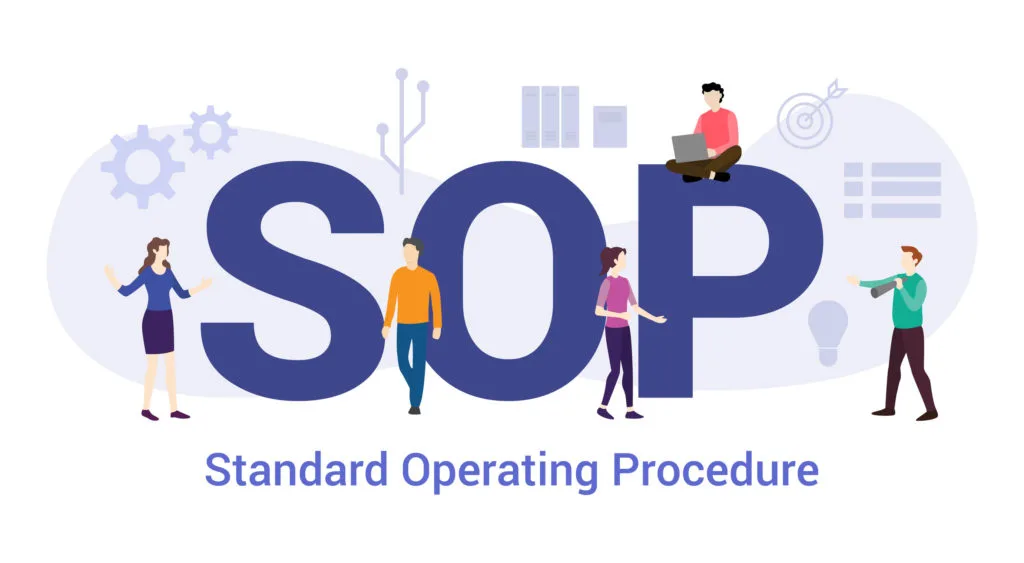Business SOPs to Successful Streamline Processes
In any business, both big and small, having set procedures in place for various tasks is crucial to maintaining a sense of order and keeping things running smoothly. This is where Business Standard Operating Procedures, or Business SOPs, come in.
SOPs are simply detailed instructions on how to complete a specific task or process. They can be as general as outlining the steps of opening and closing the store each day, or as specific as describing exactly how to make a particular product.
No matter what they cover, their purpose is always the same: to ensure that everyone involved understands what needs to be done and that it gets done the same way every time.
Creating SOPs can seem like a daunting task, but it doesn’t have to be. Start by taking a close look at your business and identifying which areas could benefit from having more structure.
The Benefits of Business Standard Operating Procedures

There are many benefits that businesses can gain from implementing standard operating procedures (SOPs). It can improve efficiency and productivity by providing clear guidelines for employees to follow. They can also help to improve communication within the organization and reduce errors. In addition, It can help businesses to ensure compliance with regulatory requirements.
SOPs can help businesses to streamline their operations by eliminating unnecessary steps and duplication of effort. They can also help to improve quality control by ensuring that all employees are following the same procedures.
It can also simplify training for new employees and make it easier for them to understand the company’s processes.
Overall, SOPs can provide numerous benefits for businesses. Improving efficiency and quality control, while also helping to ensure compliance with regulations, can help businesses to save time and money.
How to Write an SOP

Business SOPs, or business standard operating procedures, are an important part of any business. They help to streamline processes and make sure that everyone is on the same page. Writing an SOP can seem daunting, but it doesn’t have to be. Here are a few tips to help you get started:
1. Define the purpose of the SOP. What is its goal? What process will it be describing?
2. Keep it simple. Use clear and concise language that can be understood by everyone.
3. Be specific. Include all the details that someone would need to follow the procedure correctly.
4. Make it easy to follow. Use step-by-step instructions and include any relevant diagrams or screenshots.
5. Test it out. Try following the SOP yourself to make sure it works as intended.
Use PDCA (Plan, Do, Check and Act) To Create SOP

Standard operating procedures are an important part of any business. They help to streamline processes and make sure that everyone is on the same page. PDCA, or Plan, Do, Check and Act, is a great way to create SOPs.
First, you need to identify the problem that you’re trying to solve with the SOP. What task do you want to streamline? Once you’ve identified the problem, you can start planning your business SOP. What steps will be involved? Who will be responsible for each step?
The PDCA method for streamlining business processes is simple yet effective. By breaking down the tasks into smaller manageable steps, businesses can easily see improvements in efficiency and overall quality.
The first step, “Plan”, is where you identify the problem and create your SOP. In this stage, brainstorming lists out all the solutions and step-by-step ways to solve a problem.
The second step, “Do”, is where you actually put the SOP into action. This is where businesses decide what needs to be done and establish procedures to get it done.
The third step, “Check”, is where you evaluate your SOP to see if it’s working. This is all about measuring progress and determining whether or not the procedures are working as intended. This step helps businesses identify areas that need improvement.
The fourth step, “Act”, is where you make any necessary changes to your SOP and put it back into action. It’s all about making adjustments to the plan when they become necessary. This step focuses on capitalizing on the gains that have been made by maximizing efficiency and effectiveness.
With PDCA, businesses can easily streamline their business processes by identifying, creating, and implementing effective business standard operating procedures.
An SOP is a set of step-by-step instructions that outline how a task should be completed. It eliminates ambiguity and ensures that everyone is on the same target. When something goes wrong, you can just redo step one and continue until all other procedures are error-free.
SOPs are essential for businesses of all sizes. They help to improve efficiency and productivity, while also reducing costs. Having SOPs in place will give you a competitive advantage and help your business run like a well-oiled machine.
Implementing an SOP System in Your Business

Implementing an SOP system in your business can be beneficial in many ways. First, it can help to improve efficiency by reducing the need for training on specific tasks. Second, it can help to improve quality by ensuring that tasks are completed consistently and correctly. Finally, it can help to reduce costs by eliminating waste and rework.
Typically, the business standard operating procedures will be implemented in a step-by-step manner. You can begin by creating an SOP for some of the basic tasks that employees perform on a regular basis. From there, you can work on more complex procedures and add them to your system.
Maintaining Standard Operating Procedures

Standard operating procedures, or SOPs, are an important part of any business. They help to streamline processes and ensure that everyone is on the same page.
Creating it can be a daunting task, but it is important to take the time to do it right. Once you have created your SOPs, it is important to maintain them. Here are a few tips for maintaining your SOPs:
1. Keep them up to date: As your business grows and changes, so too will your SOPs. Make sure to keep them up to date, so that they always reflect the current state of your business.
2. Train new employees: When you have new employees start at your company, make sure to train them on your SOPs. This will help them hit the ground running and avoid any confusion down the line.
3. Revise your SOPs or rewrite them When you find errors or omissions in your SOPs, it is important to make the appropriate changes.
4. Have a designated person responsible for your SOPs This will help ensure that the SOPs are always up to date, and are not left behind by your business.
Conclusion: What are SOPs in Business?

While businesses need standard operating procedures to streamline processes, it is also important for them to be flexible. Business SOPs should not be so rigid that they cannot be adapted to changing circumstances. Otherwise, they can become a hindrance to the business rather than a help.
In conclusion, businesses need to find a balance between having too many procedures and not enough. The right amount of SOPs can help to streamline processes and make the business run more smoothly. However, too many of them can be just as detrimental as having none at all.
All businesses should have SOPs to keep well-organized, hope your company does so. Start to develop it today to improve your organization.
If you found something valuable, please help me share it with others, I’d appreciate it. For any discussion, please leave a message below. Thank you for reading.




